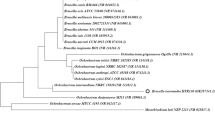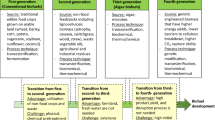Abstract
In this study, two indigenous bacterial strains (Ab9-ES and Ab33-ES) isolated from lipid-rich wastewater showed potential to produce bioemulsifier in the presence of 2% (v/v) olive oil as a carbon source. These bacterial strains were identified as Acinetobacter sp. Ab9-ES and Acinetobacter sp. Ab33-ES by polymerase chain reaction and analysis of 16S rRNA gene sequences. Bioemulsifier production by these strains was found to be growth-linked. Maximum emulsifying activities (83.8% and 80.8%) were recorded from strains Ab9-ES and Ab33-ES, respectively. Bioemulsifier yields of 4.52 g/L and 4.31 g/L were obtained from strains Ab9-ES (XB9) and Ab33-ES (YB33), respectively. Fourier-transform infrared spectroscopic analysis revealed the glycoprotein nature of the bioemulsifiers. The bioemulsifiers formed stable emulsions only in the presence of edible oils. Maximum emulsifying activities of 79.6% (XB9) and 67.9% (YB33) were recorded in the presence of sunflower oil. The bioemulsifiers were found to be stable at a broad range of temperature (4–121 °C), moderate pH (5.0–10.0) and salinity (1–6%). In addition, bioemulsifier XB9 showed maximum emulsifying activities (77.3%, 74.5%, and 74.9%) at optimum temperature (50 °C), pH (7.0), and NaCl concentration (3%), respectively. On the contrary, YB33 demonstrated highest activities (73.6%, 72%, and 61.2%) at optimum conditions of 70 °C, pH 7.0, and NaCl concentration of 5%, respectively. Findings from this study suggest the potential biotechnological applications of the bioemulsifiers, especially in the remediation of oil-polluted sites.





Similar content being viewed by others
References
Adetunji AI, Olaniran AO (2018a) Treatment of lipid-rich wastewater using a mixture of free or immobilized bioemulsifier and hydrolytic enzymes from indigenous bacterial isolates. Desalin Water Treat 132:274–280
Adetunji AI, Olaniran AO (2018b) Optimization of culture conditions for enhanced lipase production by an indigenous Bacillus aryabhattai Ab15-ES using response surface methodology. Biotechnol Biotechnol Equip 32(6):1514–1526
Akinbowale OL, Peng H, Grant P, Barton MD (2007) Antibiotic and heavy metal resistance in motile aeromonads and pseudomonads from rainbow trout (Oncorhynchus mykiss) farms in Australia. Int J Antimicrob Agents 30(2):177–182
Aparna A, Srinikethan G, Smitha H (2012) Production and characterization of biosurfactant produced by a novel Pseudomonas sp. 2B. Coll Surf B 95:23–29
Banat IM, Franzetti A, Gandolfi I, Bestetti G, Martinotti MG, Fracchia L, Smyth TJ, Marchant R (2010) Microbial biosurfactants production, applications and future potential. Appl Microbiol Biotechnol 87(2):427–444
Banat IM, Satpute SK, Cameotra SS, Patil R, Nyayanit NV (2014) Cost effective technologies and renewable substrates for biosurfactants’ production. Front Microbiol 5:697
Batista SB, Mounteer AH, Amorim FR, Tótola MR (2006) Isolation and characterization of biosurfactant/bioemulsifier-producing bacteria from petroleum contaminated sites. Bioresour Technol 97(6):868–875
Bhattacharya M, Biswas D, Sana S, Datta S (2014) Utilization of waste engine oil by Ochrobactrum pseudintermedium strain C1 that secretes an exopolysaccharide as a bioemulsifier. Biocatal Agric Biotechnol 3(4):167–176
Camacho-Chab JC, Guézennec J, Chan-Bacab MJ, Ríos-Leal E, Sinquin C, Muñiz-Salazar R, De la Rosa-García SDC, Reyes-Estebanez M, Ortega-Morales BO (2013) Emulsifying activity and stability of a non-toxic bioemulsifier synthesized by Microbacterium sp. MC3B-10. Int J Mol Sci 14(9):18959–18972
Christensen BE (1989) The role of extracellular polysaccharides in biofilms. J Biotechnol 10(3–4):181–202
Cirigliano MC, Carman GM (1984) Isolation of a bioemulsifier from Candida lipolytica. Appl Environ Microbiol 48(4):747–750
Cooper DG (1986) Biosurfactants. Microbiol Sci 3(5):145–149
Cooper DG, Goldenberg BG (1987) Surface-active agents from two Bacillus species. Appl Environ Microbiol 53(2):224–229
Dastgheib SMM, Amoozegar MA, Elahi E, Asad S, Banat IM (2008) Bioemulsifier production by a halothermophilic Bacillus strain with potential applications in microbially enhanced oil recovery. Biotechnol Lett 30(2):263–270
Dubois M, Gilles KA, Hamilton JK, Rebers PA, Smith F (1956) Colorimetric method for determination of sugars and related substances. Anal Chem 28(3):350–356
Foght JM, Gutnick DL, Westlake DWS (1989) Effect of emulsan on biodegradation of crude oil by pure and mixed bacterial cultures. Appl Environ Microbiol 55(1):36–42
Folch J, Lees M, Stanley GHS (1957) A simple method for the isolation and purification of total lipids from animal tissues. J Biol Chem 226(1):497–509
Franzetti A, Gandolfi I, Raimondi C, Bestetti G, Banat IM, Smyth TJ, Papacchini M, Cavallo M, Fracchia L (2012) Environmental fate, toxicity, characteristics and potential applications of novel bioemulsifiers produced by Variovorax paradoxus 7bCTS. Bioresour Technol 108:245–251
Freitas F, Alves V, Carvalheira M, Costa N, Oliveira R, Reis M (2009) Emulsifying behavior and rheological properties of the extracellular polysaccharide produced by Pseudomonas oleovorans grown on glycerol byproduct. Carbohydr Polym 78(3):549–556
Gudiña EJ, Pereira JFB, Costa R, Evtuguin DV, Coutinho JAP, Teixeira JA, Rodrigues LR (2015) Novel bioemulsifier produced by a Paenibacillus strain isolated from crude oil. Microb Cell Fact 14:14
Haba E, Espuny MJ, Busquets M, Manresa A (2000) Screening and production of rhamnolipids by Pseudomonas aeruginosa 47T2 NCIB40044 from waste frying oils. J Appl Microbiol 88(3):379–387
Joshi S, Bharucha C, Desai AJ (2008) Production of biosurfactant and antifungal compound by fermented food isolate Bacillus subtilis 20B. Bioresour Technol 99(11):4603–4608
Kiran GS, Thomas TA, Selvin J, Sabarathnam B, Lipton AP (2010) Optimization and characterization of a new lipopeptide biosurfactant produced by marine Brevibacterium aureum MSA 13 in solid state culture. Bioresour Technol 101:2389–2396
Kitamoto D, Isoda H, Nakahara T (2002) Functions and potential applications of glycolipid biosurfactants: from energy-saving materials to gene delivery carriers. J Biosci Bioeng 94(3):187–201
Lowry OH, Rosebrough NJ, Farr AI, Randall RJ (1951) Protein measurement with folin phenol reagent. J Biol Chem 193(1):265–275
Luna JM, Rufino RD, Campos-Takaki GM, Sarubbo LA (2012) Properties of the biosurfactant produced by Candida sphaerica cultivated in low-cost substrates. Chem Eng Trans 27:67–72
Luna-Velasco MA, Esparza-Garcia F, Canizares-Villanueva RO, Rodriguez-Vazquez R (2007) Production and properties of a bioemulsifier synthesized by phenanthrene-degrading Penicillium sp. Proc Biochem 42(3):310–314
Marchant R, Funston S, Uzoigwe C, Rahman PKSM, Banat IM (2014) Production of biosurfactants from nonpathogenic bacteria. In: Kosaric N, Sukan FV (eds) Biosurfactants: production and utilization- processes, technologies, and economics. CRC Press, Boca Raton, pp 73–82
Marchesi JR, Sato T, Weightman AJ, Martin TA, Fry JC, Hiom SJ, Dymock D, Wade WG (1998) Design and evaluation of useful bacterium-specific PCR primers that amplify genes coding for bacterial 16S rRNA. Appl Environ Microbiol 64(2):795–799
Markande AR, Acharya SR, Nerurkar AS (2013) Physicochemical characterization of a thermostable glycoprotein bioemulsifier from Solibacillus silvestris AM1. Proc Biochem 48(11):1800–1808
Morikawa M, Hirata Y, Imanaka T (2000) A study on the structure-function relationship of the lipopeptide biosurfactants. Biochem Biophy Acta 1488(3):211–218
Mulligan CN (2005) Environmental applications for biosurfactants. Environ Pollution 133(2):183–198
Navon-Venezia S, Zosim Z, Gottlieb A, Legmann R, Carmeli S, Ron EZ, Rosenberg E (1995) Alasan, a new bioemulsifier from Acinetobacter radioresistens. Appl Environ Microbiol 61(9):3240–3244
Pansiripat S, Pornsunthorntawee O, Rujiravanit R, Kitiyanan B, Somboonthanate P, Chavadej S (2010) Biosurfactant production by Pseudomonas aeruginosa SP4 using sequencing batch reactors: effect of oil-to-glucose ratio. Biochem Eng J 49(2):185–191
Patil JR, Chopade BA (2001) Studies on bioemulsifier production by Acinetobacter strains isolated from healthy human skin. J Appl Microbiol 91(2):290–298
Patowary K, Patowary R, Kalita MC, Deka S (2017) Characterization of biosurfactant produced during degradation of hydrocarbons using crude oil as sole source of carbon. Front Microbiol 8:279
Phetrong K, Kittikun AH, Maneerat S (2008) Production and characterization of bioemulsifier from a marine bacterium, Acinetobacter calcoaceticus subsp. anitratus SM7 Songklanakarin J Sci Technol 30(3):297–305(
Pornsunthorntawee O, Arttaweeporn N, Paisanjit S, Somboonthanate P, Abe M, Rujiravanit R, Chavadej S (2008) Isolation and comparison of biosurfactants produced by Bacillus subtilis PT2 and Pseudomonas aeruginosa SP4 for microbial surfactant-enhanced oil recovery. Biochem Eng J 42(2):172–179
Rosenberg E (1986) Microbial surfactants. Critical Rev Biotechnol 3:109–132
Rosenberg E, Ron EZ (1999) High- and low-molecular mass microbial surfactants. Appl Microbiol Biotechnol 52(2):154–162
Rosenberg E, Rubinovitz C, Gottlieb A, Rosenhak S, Ron EZ (1988) Production of biodispersan by Acinetobacter calcoaceticus A2. Appl Environ Microbiol 54(2):317–322
Rupani PF, Singh RP, Ibrahim MH, Esa N (2010) Review of current palm oil mill effluent (POME) treatment methods: vermicomposting as a sustainable practice. World Appl Sci J 11(1):70–81
Saisa-ard K, Maneerat S, Saimmai A (2013) Isolation and characterization of biosurfactant-producing bacteria isolated from palm oil industry and evaluation for biosurfactants production using low-cost substrates. Bio Technol 94(3):275–284
Santos DKF, Rufino RD, Luna JM, Santos VA, Sarubbo LA (2016) Biosurfactants: multifunctional biomolecules of the 21st century. Int J Mol Sci 17(3):401
Sar N, Rosenberg E (1983) Emulsifier production by Acinetobacter calcoaceticus strains. Curr Microbiol 9(6):309–313
Sarubbo LA, Marcal MC, Neves MLC, Silva MPC, Porto ALF, Campos-Takaki GM (2001) Bioemulsifier production in batch culture using glucose as carbon source by Candida lipolytica. Appl Biochem Biotechnol 95(1):59–67
Sarubbo LA, Farias CBB, Campos-Takaki GM (2007) Co-utilization of canola oil and glucose on the production of a surfactant by Candida lipolytica. Curr Microbiol 54(1):68–73
Slavov AK (2017) General characteristics and treatment possibilities of dairy wastewater—a review. Food Technol Biotechnol 55(1):14–28
Stuart BH (2004) Organic molecules. In Stuart BH (Ed.), Infrared spectroscopy: fundamental and applications, Wiley, New Jersey, pp 44–70
Tamura K, Stecher G, Peterson D, Filipski A, Kumar S (2013) MEGA 6: molecular evolutionary genetics analysis version 6.0. Mol Biol Evo 30(12):2725–2729
Uzoigwe C, Burgess JG, Ennis CJ, Rahman PKSM (2015) Bioemulsifiers are not biosurfactants and require different screening approaches. Front Microbiol 6:245
Zheng C, Li Z, Su J, Zhang R, Liu C, Zhao M (2012) Characterization and emulsifying property of a novel bioemulsifier by Aeribacillus pallidus YM-1. J Appl Microbiol 113(1):44–51
Acknowledgements
The financial support of the National Research Foundation (NRF) of South Africa towards this research is hereby acknowledged. Opinions expressed and conclusions arrived at, are those of the authors and are not necessarily to be attributed to the NRF. The first author is thankful to Dr. Ajit Kumar for providing technical assistance to accomplish the research work.
Author information
Authors and Affiliations
Corresponding author
Ethics declarations
Conflict of interest
The authors declare that they have no conflict of interest in the publication of this paper.
Rights and permissions
About this article
Cite this article
Adetunji, A.I., Olaniran, A.O. Production and characterization of bioemulsifiers from Acinetobacter strains isolated from lipid-rich wastewater. 3 Biotech 9, 151 (2019). https://doi.org/10.1007/s13205-019-1683-y
Received:
Accepted:
Published:
DOI: https://doi.org/10.1007/s13205-019-1683-y




